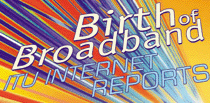Structure
of the report
The report aims to explore the aspects of broadband mentioned here in
greater depth, taking a variety of different angles. In doing so, we hope
to reflect an international, global perspective, that also offers detailed
close-ups of broadband in practice in people’s lives everywhere. Every
effort has been made to describe specialized, technical details in simple
terms, so that readers from all backgrounds will be able to understand
more easily areas that are not of their particular specialization. We also
hope that the different policy and strategy aspects of promoting
broadband, developing infrastructure and content, and supplying them to
the user, offer useful insights to all interested parties. To that end,
the chapters have been broken down to cover different areas as follows:
 Chapter Two: Technologies for Broadband
Chapter Two: Technologies for Broadband
Several technology platforms are using the tag “broadband”, but
what does it mean and what does it imply for differences in service
quality? There are a variety of broadband platforms, including ADSL and
cable modem as well as between more recent arrivals, such as wireless
LANs, fixed wireless or fibre in the access network. Will these different
technologies continue to coexist? Is the absence of a cable television
network a barrier to broadband take-up? Click here
for a summary of the chapter.

Chapter Three: Supplying Broadband
Many different companies have entered the broadband arena, but in the
majority of ITU Member States, it is the incumbent fixed-line operator
that has emerged as the dominant provider. What are the dynamics of the
broadband market and what corporate strategies have been most successful
in winning market share? What pricing strategies have been most effective
and how do prices vary between countries? Is broadband relevant for
developing nations? Can broadband be supplied effectively on a community
access model? Click here
for a summary of the chapter.
 Chapter Four: Using Broadband
Chapter Four: Using Broadband
Broadband users tend to be young and highly educated, and the most popular
applications at present are games and file sharing. If broadband is to
become a mass-market, the user profile will need to broaden and services
will need to be marketed also to business users. This chapter examines
which applications are currently driving broadband demand, how content
fits into the picture—including intellectual property issues—and how
usage is likely to evolve in the future. Click here
for a summary of the chapter.
 Chapter Five: Regulatory and Policy Aspects
Chapter Five: Regulatory and Policy Aspects
Fair-competition among market players is necessary to promote broadband
telecommunication. The creation of a fair-competitive environment is the
most important role for government to play. For broadband, the market
environment covers several different sectors, including cable TV as well
as telephony. What policies / regulations are helpful to promote fair,
inter-modal competition in the broadband market? What level of
cross-ownership and cross-sectoral service provision should be allowed?
Click here
for a summary of the chapter.
 Chapter Six: Promoting Broadband
Chapter Six: Promoting Broadband
As local and national governments
prepare for the challenges of the information society, there is much
interest in who is doing well, and who is doing poorly, in broadband
Internet access. Broadband access is being touted as a way for governments
to attract investment, ensure future economic prosperity and provide
enhanced social welfare. How can broadband be successfully promoted? What
are the lessons to date from successful broadband economies? Is the case
for broadband different in developing nations?
Click here
for a summary of the chapter.
 Chapter Seven: Broadband and the Information Society
Chapter Seven: Broadband and the Information Society
Broadband changes user habits, for instance by encouraging
“always-on” use and positioning the home computer as a multimedia
entertainment device. Coupled with the growth in high-speed mobile
Internet access, and the development of pervasive communications,
broadband will also change attitudes towards the information society. What
new challenges will this pose, for instance for social ethics and welfare,
and information security?
Click here
for a summary of the chapter.
The report
draws throughout on ITU country case studies on broadband development and
promotion, including Canada, Iceland, Republic of Korea, Japan, Malaysia
and Hong Kong, China, as well as further case studies on Internet
diffusion.[i]
The Statistical Tables at the end of the report
provide the latest available data on the state of broadband and
telecommunications worldwide, extracted from the ITU World Telecommunication
Indicators Database.

|